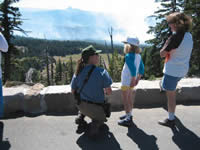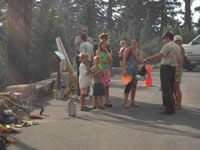
National Fire Plan Success Story
The Bybee Fire: Challenging Public Perceptions about Fire Crater Lake National Park, Oregon
National Fire Plan - Rehabilitation

An information officer talks to Crater Lake National Park visitors about the natural role of fire.

Crater Lake National Park visitors learn about fire as a natural process about the tools and methods used by fire managers.
The Bybee Fire, a lightning-ignited fire in Crater Lake National Park's backcountry, was allowed to spread naturally for 12 weeks during the busy summer season in 2006. The fire started after a storm passed through the area on July 21 and was highly visible to visitors from the Union Peak overlook along the Crater Lake Highway. It eventually grew to 2,930 acres. Three months later, the fire was naturally extinguished.
The fire posed no threat to lives, structures, or critical natural resources in the park so fire managers took advantage of the opportunity to return fire to its natural cycle in the ecosystem. During the last century, fire was excluded in the park, causing trees to encroach on meadows and shrublands. Gaps in forest canopies and meadows, essential for park wildlife, occurred naturally before exclusion. By managing the Bybee Fire, the park took a first step in returning fire to its natural role in the ecosystem. The use of fire will increase meadowlands and shrublands that are important to meadow and shrubdependent wildlife and birds. Fire also maintains diverse habitats by creating mosaics of young and old forests mixed with grass and shrubfields. Natural fire periodically clears the forest of dead vegetation that has accumulated that if left uncleared, can potentially lead to higher intensity fires. Many species have adapted to thousands of years of natural fire and use fire for germination and growth. Fire is as much a natural component of the park's ecosystem as rain and snow.
This highly visible fire provided an excellent educational opportunity for visitors to the park. Visitors had the opportunity to interact with public information officers and firefighters, learning about the tools of the trade, and coming to understand that managing fire for resource benefits is one of the options for park and fire managers. Public information officers contacted between 300-500 people a day and even provided the public a chance to comment about the natural event they were seeing. The Bybee Fire demonstrated to visitors of Crater Lake National Park that fire is not always a destructive force, but rather a renewing one.
Contact: Brad Reed, Fire Management Officer
Phone: (541) 594-3062